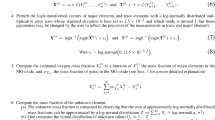Abstract
The geochemistry of floodplain sediments is fundamental to monitor environmental changes and to quantify their contribution to natural and anthropic processes. A floodplain sediment composition is a vector of positive elements which sum to a fixed constant. The analysis of high-dimensional compositions requires methods that produce results involving only a small portion of the original variables. On the other hand, the analysis must take into account the additional constraints specific to compositions. With the purpose of studying these problems, a new procedure for sparse PCA is proposed on European floodplain sediment samples.



Similar content being viewed by others
References
Aitchison J (1982) The statistical analysis of compositional data. J R Stat Soc Ser B (Methodol) 44(2):139–177
Aitchison J (1983) Principal component analysis of compositional data. Biometrika 70:57–65
Aitchison J (1986) The statistical analysis of compositional data. Chapman and Hall, London
Aitchison J, Greenacre M (2002) Biplots of compositional data. J R Stat Soc Ser C (Appl Stat) 51:375–392
Baize D, Sterckeman T (2001) Of the necessity of knowledge of the natural pedo-geochemical background content in the evaluation of the contamination of soils by trace elements. Sci Total Environ 264:127–139
Billheimer D, Guttorp P, Fagan W (2001) Statistical interpretation of species composition. J Am Stat Assoc 456:1205–1214
Boumal N, Mishra B, Absil P-A, Sepulchre R (2014) Manopt: a Matlab toolbox for optimization on manifolds. J Mach Learn Res 15:1455–1459
Buccianti A, Lima A, Albanese S, Cannatelli C, Esposito R, De Vivo B (2015) Exploring topsoil geochemistry from the CoDA (compositional data analysis) perspective: the multi-element data archive of the Campania Region (Southern Italy). J Geochem Explor 159:302–316
De Vos W, Tarvainen T, Salminen R, Reeder S, De Vivo B, Demetriades A, Pirc S, Batista MJ, Marsina K, Ottesen RT, O’Connor PJ, Bidovec M, Lima A, Siewers U, Smith B, Taylor H, Shaw R, Salpeteur I, Gregorauskiene V, Halamic J, Slaninka I, Lax K, Gravese P, Birke M, Breward N, Ander EL, Jordan G, Duris M, Klein P, Locutura J, Bel-Lan A, Pasieczna A, Lis J, Mazreku A, Gilucis A, Heitzmann P, Klaver G, Petersell V (2006) Geochemical Atlas of Europe. Part 2. Interpretation of Geochemical Maps, Additional Tables, Figures, Maps, and Related Publications. Geological Survey of Finland, Espoo. ISBN: 951-690-956-6
Egozcue JJ, Pawlowsky-Glahn V, Mateu-Figueras G, Barcelo-Vidal C (2003) Isometric logratio transformations for compositional data analysis. Math Geol 35(3):279–300
Egozcue J, Pawlowsky-Glahn V (2005) Groups of parts and their balances in compositional data analysis. Math Geol 37:795–820
Egozcue JJ, Barcelo-Vidal C, Martín-Fernández JA, Jarauta-Bragulat E, Díaz-Barrero JL, Mateu-Figueras G (2011) Elements of simplicial linear algebra and geometry, compositional data analysis: theory and applications. Wiley, Chichester
Engle MA, Gallo M, Schroeder KT, Geboy NJ, Zupancic JW (2014) Three-way compositional analysis of water quality monitoring data. Environ Ecol Stat 21(3):565–581
Gallo M, Buccianti A (2013) Weighted principal component analysis for compositional data: application example for the water chemistry of the Arno river (Tuscany, central Italy). Environmetrics 24(4):269–277
Jolliffe IT (2002) Principal component analysis, 2nd edn. Springer, New York
Mert MC, Filzmoser P, Hron H (2015) Sparse principal balances. Stat Model 15:159–174
Pawlowsky-Glahn V, Egozcue J (2001) Geometric approach to statistical analysis on the simplex. Stoch Environ Res Risk Assess 15:38–398
Pawlowsky-Glahn V, Buccianti A (2011) Compositional data analysis: theory and applications. Wiley, London
Salminen R, Batista MJ, Bidovec M, Demetriades A, De Vivo B, De Vos W, Gilucis A, Gregorauskiene V, Halamic J, Heitzmann P, Lima A, Jordan G, Klaver G, Klein P, Lis J, Locutura J, Marsina K, Mazreku A, Mrnkova J, O’Connor P. J, Olsson S, Ottesen R-T, Petersell V, Plant JA, Reeder S, Salpeteu I, Sandström H, Siewers U, Steenfelt A, Tarvaine T (2005) FOREGS Geochemical Atlas of Europe. Part 1. Background Information, Methodology, and Maps. Geological Survey of Finland, Espoo. ISBN: 951-690-913-2 http://www.gtk/publ/foregsatlas, March 15, 2005
Salpeteur I, Locutura J, Tyráek J (2005) A brief summary of the Tertiary-Quaternary landscape evolution focusing on palaeodrainage settlement on the European Shield. Salminen (Chiefeditor) R, Batista MJ, Bidovec M, Demetriades A, De Vivo B, De Vos W, Duris M, Gilucis A, Gregorauskiene V, Halamic J, Heitzmann P, Lima A, Jordan G, Klaver G, Klein P, Lis J, Locutura J, Marsina K, Mazreku A, O’Connor PJ, Sölsson RT, Ottesen V Petersell, Plant JA, Reeder S, Salpeteur I, Sandström H, Siewers U, Steenfelt A, Tarvainen T FOREGS Geochemical Atlas of Europe, Part 1: Background Information. Methodology and Maps. Geological Survey of Finland, Espoo, pp 51–61
Tibshirani R (1996) Regression shrinkage and selection via the LASSO. J R Stat Soc B 58:267–288
Trendafilov N, Jolliffe I (2006) Projected gradient approach to the numerical solution of the SCoTLASS. Comput Stat Data Anal 50:242–253
Trendafilov NT (2012) DINDSCAL: direct INDSCAL. Stat Comput 22:445–454
Trendafilov NT (2014) From simple structure to sparse components: a review. Comput Stat 29:431–454
Zou H, Hastie T, Tibshirani R (2006) Sparse principal component analysis. J Comput Graph Stat 15(2):265–286
Author information
Authors and Affiliations
Corresponding author
Additional information
Handling Editor: Bryan F. J. Manly.
Rights and permissions
About this article
Cite this article
Gallo, M., Trendafilov, N.T. & Buccianti, A. Sparse PCA and investigation of multi-elements compositional repositories: theory and applications. Environ Ecol Stat 23, 421–434 (2016). https://doi.org/10.1007/s10651-016-0346-y
Received:
Revised:
Published:
Issue Date:
DOI: https://doi.org/10.1007/s10651-016-0346-y




